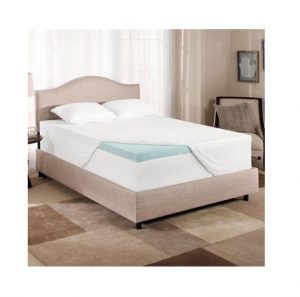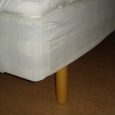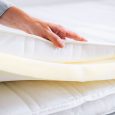
Mattress toppers are an inexpensive way to adjust the firmness of your bed. Plus, it helps reduce any dents or sags in your mattress. In this post, we are going to be looking at Mattress Topper Buying Guide.
Shopping for a mattress topper may seem complicated at first, but it is not that difficult if you know what to look for.
When selecting a mattress topper, there are many factors to take into account such as thickness, density, material and style. This mattress topper buying guide will assist you in finding the ideal mattress topper for your individual needs.
Mattress Topper Buying Guide – Comfort
No matter if you prefer softness or contoured support, your mattress topper can make a significant difference in comfort levels. Toppers come in various materials like latex, memory foam, wool or down alternative and come with various levels of filling for optimal support and softness.
While toppers made from each material offer distinct advantages, you should take into account your personal priorities and needs before making a final decision. For instance, if you’re looking for an eco-friendly option, organic cotton may be your best bet.
When selecting a mattress topper, the thickness of your layer plays an important role in its comfort. A firmer topper offers more cushioning than soft one, so take this into account when making your selection.
Mattress toppers are measured for firmness using Indentation Load Deflection (ILD), which measures the force needed to compress foam samples to 25% of their original height. The higher the ILD number, the firmer the topper will feel.
Mattress Topper Buying Guide – Durability
When it comes to durability, the materials used in a mattress topper are essential. High quality mattress toppers tend to stay firm for extended periods while cheaper ones may go flat or develop impressions over time.
A topper should also be designed to dissipate heat. Cooling options can include gel- or copper-infused memory foam, ventilation holes, and breathable fabrics like cotton or wool.
Durability can also be affected by how often a mattress topper is cleaned. Washing frequently and following the manufacturer’s cleaning guidelines reduces premature wear.
Memory foam is a popular mattress topper due to its contouring ability and slow bounce back from pressure points. Other foams may take less time to bounce back after applying pressure, while memory foam takes the longest.
Thickness
The thickness of a mattress topper can make a big difference in comfort levels. Thicker toppers typically feel plusher, while thinner ones provide less “give” for bodies to rest on comfortably.
In addition to the material a mattress topper is constructed from, its thickness also affects how it fits on your bed. A mattress pad typically has an elastic skirt while a mattress topper features corner straps that keep it securely in place.
If you’re in search of a thick mattress topper, natural latex may be your ideal material. This natural material boasts excellent elasticity and can help contour your body to the bed surface while relieving pressure points – especially for side sleepers.
Density
The density of a mattress topper is an important factor that affects the comfort and support of the bed. Generally speaking, higher density toppers provide more support than their lower density counterparts.
The thickness of a topper is another important factor when it comes to how well it works on the bed. Thinner toppers may feel too soft and could cause the bed to shift or roll out of position.
If you’re searching for a mattress topper that offers more support, try three or four inches thick with high density. These have greater weight-bearing capacity than other options and may help alleviate back, joint, or neck pain.
Material
When shopping for a mattress topper, the material is important to take into account. Toppers come in an assortment of materials and fills, and the choice you make will ultimately affect how comfortable your bed feels.
Memory foam is an ideal choice if you need support and firmness. However, it can trap body heat, so if you tend to overheat easily, consider switching it out for a natural latex topper.
Natural latex comes in a range of densities from soft to extra firm. It’s more durable than petroleum-based foams and doesn’t feel as hot. Plus, natural latex tends to be resistant to dust mites and microbes, making it an ideal choice for people with allergies.
Style
Mattress toppers are an economical way to make your existing bed more comfortable, whether you prefer softness or firm support. But it’s essential that you purchase one that meets your individual needs.
Sleepers who struggle with temperature regulation may want to consider a mattress topper that provides support and breaths, particularly foam toppers which tend to trap heat. Furthermore, make sure the topper is durable and resistant to excess moisture buildup.
If you’re worried about bacterial growth, check the label to see if your topper is washable. Most toppers can be machine washed, but for best results it may need to air-dry at the lowest possible temperature.
Mattress Topper Buying Guide – Warranty
Mattress toppers typically come with a manufacturer’s warranty of 10 to 15 years. In order to make a claim, you’ll need proof of purchase (such as an original sales receipt) and the valid law tag from the store or factory.
Furthermore, the manufacturer will not honour a claim if you have mistreated or misused your topper in any way, including roughhousing, spills, bodily fluids and cuts.
Your topper may show signs of permanent compression on its foam surface if it measures more than one inch in depth, including splits or cracks in latex foam that affect your comfort during sleep.
Mattress Topper Buying Guide – Price
The cost of a mattress topper varies based on several factors, including its type and thickness. Generally speaking, higher prices indicate better quality products – so it pays off to invest in something highly-rated for added peace of mind.
Selecting the ideal topper requires more than comfort and support–it must also be durable enough to last for years. Ultimately, what works best for you depends on your individual requirements and priorities.
When selecting a mattress topper, it’s essential to take into account your sleep style. For instance, certain materials regulate body heat better than others.
If you’re a back or side sleeper, a memory foam topper may be ideal. It contours to your body for an invigorating experience while trapping heat – which could be an issue if you tend to get warm at night.



